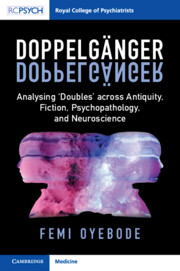94 results
Voices from an Unusual Archive: University Film Circle Writings, 1945-1960
-
- Journal:
- Asia-Pacific Journal / Volume 21 / Issue 6 / June 2023
- Published online by Cambridge University Press:
- 14 March 2025, e3
-
- Article
- Export citation

Doppelgänger
- Analysing ‘Doubles' across Antiquity, Fiction, Psychopathology, and Neuroscience
-
- Published online:
- 13 March 2025
- Print publication:
- 20 March 2025
6 - American Popular Visual Culture and Ireland, 1840s–1920s
-
-
- Book:
- America in Ireland
- Published online:
- 09 January 2025
- Print publication:
- 23 January 2025, pp 144-175
-
- Chapter
- Export citation
21 - Ancient Greek Epic and the Cinema
- from Part VI - Epic Without End
-
-
- Book:
- The Cambridge Companion to Ancient Greek Epic
- Published online:
- 04 December 2024
- Print publication:
- 28 November 2024, pp 442-459
-
- Chapter
- Export citation
The Challenges of Transforming Political Consciousness - Making New People: Politics, Cinema and Liberation in Burkina Faso, 1983-1987 James E. Genova. East Lansing: Michigan State University Press, 2023. Pp. 286. $34.95, paperback (ISBN: 9781611864397); $34.95, ebook (ISBN: 9781628954777).
-
- Journal:
- The Journal of African History / Volume 65 / Issue 2 / July 2024
- Published online by Cambridge University Press:
- 20 November 2024, pp. 281-282
-
- Article
-
- You have access
- HTML
- Export citation
Learning to Live-with Climate Change through Film: The Arche-Cinema of Gummo as Climating and Becoming-Climate
-
- Journal:
- Australian Journal of Environmental Education / Volume 40 / Issue 5 / October 2024
- Published online by Cambridge University Press:
- 28 October 2024, pp. 845-862
-
- Article
-
- You have access
- Open access
- HTML
- Export citation

Citizen Cowboy
- Will Rogers and the American People
-
- Published online:
- 16 August 2024
- Print publication:
- 29 August 2024
Chapter 6 - The Balkans and Ruritania
- from Part I - Zones of Influence
-
-
- Book:
- Europe in British Literature and Culture
- Published online:
- 06 June 2024
- Print publication:
- 13 June 2024, pp 100-116
-
- Chapter
- Export citation
The Report Versus the Transparency Models of Appreciation: The Case of Comics
-
- Journal:
- Canadian Journal of Philosophy / Volume 53 / Issue 7-8 / October 2023
- Published online by Cambridge University Press:
- 20 May 2024, pp. 548-558
-
- Article
-
- You have access
- HTML
- Export citation
Introduction: Gender and work in twentieth-century Italy: new approaches
-
- Journal:
- Modern Italy / Volume 29 / Issue 2 / May 2024
- Published online by Cambridge University Press:
- 02 April 2024, pp. 121-129
- Print publication:
- May 2024
-
- Article
-
- You have access
- HTML
- Export citation
Chapter 17 - Film
- from Part III - Composition, Creation, and Reception
-
-
- Book:
- Leonard Bernstein in Context
- Published online:
- 06 April 2024
- Print publication:
- 28 March 2024, pp 140-148
-
- Chapter
- Export citation
Chapter 28 - Modernity
- from Part V - Culture and Society
-
-
- Book:
- Pirandello in Context
- Published online:
- 14 March 2024
- Print publication:
- 21 March 2024, pp 227-234
-
- Chapter
- Export citation
Chapter 27 - Cinema
- from Part V - Culture and Society
-
-
- Book:
- Pirandello in Context
- Published online:
- 14 March 2024
- Print publication:
- 21 March 2024, pp 219-226
-
- Chapter
- Export citation
Chapter 2 - “The English Language Was Mine; The Tradition Was Not”
-
- Book:
- V. S. Naipaul and World Literature
- Published online:
- 01 February 2024
- Print publication:
- 08 February 2024, pp 30-57
-
- Chapter
- Export citation
Chapter 14 - Cameras
- from Part II - Developments
-
-
- Book:
- Technology and Literature
- Published online:
- 30 November 2023
- Print publication:
- 14 December 2023, pp 269-285
-
- Chapter
- Export citation
31 - The American Essay Film: A Neglected Genre
- from Part IV - Toward the Contemporary American Essay (2000–2020)
-
-
- Book:
- The Cambridge History of the American Essay
- Published online:
- 28 March 2024
- Print publication:
- 14 December 2023, pp 527-544
-
- Chapter
- Export citation
Chapter 3 - Challenging Times
- from Part II - Theatre during the War
-
-
- Book:
- The Cambridge Companion to British Theatre of the First World War
- Published online:
- 19 October 2023
- Print publication:
- 19 October 2023, pp 55-73
-
- Chapter
- Export citation
Chapter 29 - Producing Puccini Today
- from Part VII - Interpreting Puccini
-
-
- Book:
- Puccini in Context
- Published online:
- 31 August 2023
- Print publication:
- 14 September 2023, pp 238-244
-
- Chapter
- Export citation
Chapter 12 - Puccini and Early Film
- from Part III - Influences and Interests
-
-
- Book:
- Puccini in Context
- Published online:
- 31 August 2023
- Print publication:
- 14 September 2023, pp 97-104
-
- Chapter
- Export citation
Media wars: Remaking the logics of propaganda in India’s wartime cine-ecologies
-
- Journal:
- Modern Asian Studies / Volume 57 / Issue 5 / September 2023
- Published online by Cambridge University Press:
- 13 September 2023, pp. 1585-1614
- Print publication:
- September 2023
-
- Article
-
- You have access
- Open access
- HTML
- Export citation


